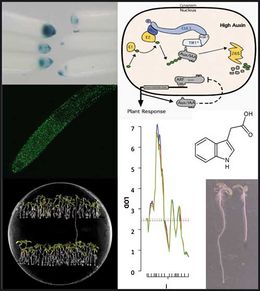Quint Lab:Research: Difference between revisions
Marcel Quint (talk | contribs) |
Marcel Quint (talk | contribs) No edit summary |
||
| Line 7: | Line 7: | ||
'''HOW''' do organisms adapt to the environment and how do they react to different biotic and abiotic stimuli? <br> | '''HOW''' do organisms adapt to the environment and how do they react to different biotic and abiotic stimuli? <br> | ||
major players in the conversion of such stimuli into cellular responses are hormones acting as signaling molecules. | major players in the conversion of such stimuli into cellular responses are hormones acting as signaling molecules. | ||
our lab is primarily interested in understanding the genetics and molecular biology of [http://en.wikipedia.org/wiki/Auxin auxin] and other [http://en.wikipedia.org/wiki/Plant_hormone plant hormone] responses in the tiny weed [http://en.wikipedia.org/wiki/Arabidopsis_thaliana arabidopsis thaliana] and related [http://en.wikipedia.org/wiki/Brassicaceae brassicaceae]. phytohormones are one of the classic fields in [http://en.wikipedia.org/wiki/Plant_physiology plant physiology] and the past has shown that understanding hormone action in plants bears great potential for agricultural and horticultural applications. by contributing to the current state of knowledge of hormone biology we hope to participate in the advancement of [http://en.wikipedia.org/wiki/Crop_science crop science]. | our lab is primarily interested in understanding the genetics and molecular biology of [http://en.wikipedia.org/wiki/Auxin auxin] and other [http://en.wikipedia.org/wiki/Plant_hormone plant hormone] responses in the tiny weed [http://en.wikipedia.org/wiki/Arabidopsis_thaliana arabidopsis thaliana] and related [http://en.wikipedia.org/wiki/Brassicaceae brassicaceae]. phytohormones are one of the classic fields in [http://en.wikipedia.org/wiki/Plant_physiology plant physiology] and the past has shown that understanding hormone action in plants bears great potential for agricultural and horticultural applications. by contributing to the current state of knowledge of hormone biology we hope to participate in the advancement of [http://en.wikipedia.org/wiki/Crop_science crop science]. | ||
Secondly, we are fascinated by the mechanisms of [http://en.wikipedia.org/wiki/Molecular_evolution molecular evolution] and how they shape plant life. Learning about the evolutionary history of signaling pathways may help to further our understanding of important developmental processes regulated by these signaling cascades. | |||
<br> | |||
we apply mostly [http://en.wikipedia.org/wiki/Genomics genomics] approaches, such as: | we apply mostly [http://en.wikipedia.org/wiki/Genomics genomics] approaches, such as: | ||
*forward [http://en.wikipedia.org/wiki/Genetic_screen genetic screens] and [http://en.wikipedia.org/wiki/Reverse_genetics reverse genetics] | *forward [http://en.wikipedia.org/wiki/Genetic_screen genetic screens] and [http://en.wikipedia.org/wiki/Reverse_genetics reverse genetics] | ||
Revision as of 03:13, 21 August 2012
 broad research scopeHOW do organisms adapt to the environment and how do they react to different biotic and abiotic stimuli? Secondly, we are fascinated by the mechanisms of molecular evolution and how they shape plant life. Learning about the evolutionary history of signaling pathways may help to further our understanding of important developmental processes regulated by these signaling cascades.
|
 natural variation and quantitative genetics of hormone responsesquantitative genetics

|
 TIR1-dependent auxin signalingto identify novel components of SCF complex regulation and/or auxin signaling we used the f-box protein and auxin receptor mutant tir1-1 for a second site forward genetic screen. in a previous screen in bill gray's lab several enhancers of tir1-1-mediated auxin resistance had been identified (see zhang et al., pnas 2008; ito and gray, plant physiology 2006; quint et al., plant journal 2005; chuang et al., plant cell 2004; gray et al., plant cell 2003). Vice versa, we are screening for suppressors of the root growth defect on auxin-supplemented (2,4-D, artificial auxin) media. we identified appr. 15 independent tir1-1 suppressor (tis) mutants that restored the wild-type response and are currently cloning the underlying gene/s and charactarize the physiological and genetic features of the mutants. |
f-box proteinsthe evolutionary conserved f-box motifs can be found in various organisms ranging from fungi, insects, fish, and mammals to plants. f-box proteins are subunits of SCF-type E3 ubiquitin ligases and selectively recruit target proteins via their protein-protein interaction domain for ubiquitination and subsequent proteasomal degradation. the arabidopsis genome encodes appr. 700 f-box proteins which makes this gene superfamily one of the largest in eukaryotes. however, a biological function has been assigned to less than 30 genes/proteins of the 700 members. We are generally interested in the evolution and selection patterns acting on f-box proteins (see Schumann et al. plant physiology 2011) and study a small sub-family to understand the molecular functions of each member. |
